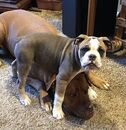NolaJane67
New member
The same thing happened to my Nash i did everything I've vinegared everything and he's never in his crate But he was for a couple of days right before this happened so I vinegared his crate tray and underneath the tray along the lip of the tray was a big ugly spider....... It cleared up and we are assuming it was a spider bite good luck




